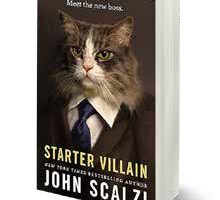Not everyone thought housing prices would increase forever. In fact, some were certain prices would plummet, and foreclosure rates would spike to historic levels. So, they placed huge bets against the entire mortgage industry. That certainly sounds un-American, doesn’t it? Unfortunately, these are actually the good guys in Michael Lewis’ latest nonfiction endeavor, “The Big Short.”If you want to make sense of the corruption that fueled the housing bubble, and the fraud that kept it booming, “The Big Short” is a good place to start. But it’s just that – a start – and a somewhat biased one at that. More on those points later; first, let’s examine what’s good about this book.Economics is not my favorite reading material, so whenever I’m going to tackle the subject, I begin by turning to the middle of the book. Most authors can hold a reader’s interest in Chapter 1, but few economic writers can keep my eyelids open for long. So, if I can get through a few pages smack-dab in the middle without falling asleep, it’s because the book was written by a highly skilled author. The “Big Short” was so engrossing that I made it from the prologue to the acknowledgments without even a yawn.Lewis reveals the dirty deeds behind the big crash through the eyes of three private investment firms and Gregg Lippmann, a bond salesman at Deutsche Bank. All had one thing in common – a desire to become filthy rich by “shorting” the mortgage bond market.Meet Steve Eisman, an arrogant Wall Streeter who doesn’t have the social graces to order lunch without offending someone. He is the essential character in this work; the one Lewis zeros in on, and I suspect Eisman acted as a channel for Lewis’ personal opinions about the housing debacle. But then it was Eisman who first called the subprime mortgage market “nothing more than a Ponzi scheme” back in the 1990s. Then, subprime mortgages were issued by institutions, such as Household Finance, under the guise of helping the “little guy” and only represented 2 percent of all mortgages issued. By 2006, 80 percent of all mortgages were subprime ilk.Subprime mortgages are a big risk for the mortgage holders because the instruments are issued to homebuyers with less-than-stellar credit ratings, with little to no down payment required. Each mortgage comes with a flexible interest rate that starts off low, but zooms higher than traditional 30 year fixed-rate mortgages after three years.Buyers had little “skin” in the loans, and many believed they would refinance before the higher rates kicked in. Loan originators and mortgage bond brokers received bonuses for bringing in these buyers, so the subprime default rates meant nothing to them.Mike Burry took notice when bond brokers began bundling subprime mortgages into packages to sell to other financial agencies as “Collateralized Debt Obligation,” commonly known as CDOs. That was in 2003. Burry has the ability to look at complicated financial documents and see what others might miss. CDOs are supposed to be “asset-backed securities,” but when Burry examined individual mortgages in the package, he realized the loans represented a worthless pile of paper. So, he began urgently searching for a way to bet against the entire CDO market.In 2005, Goldman Sachs gladly helped him; the instrument was called a “credit default swap” (CDS). CDS buyers select CDOs to bet against but only collect when mortgages in CDOs default. So, Burry selected the riskiest CDOs and purchased his CDS chips. Lewis writes, “If Mike Burry made $100 million when the subprime mortgage bond he handpicked defaulted, someone else must have lost $100 million.” But, since Goldman Sachs didn’t want to take the risk of Burry winning, they passed that on to AIG, which collected premiums from Burry for years, until his bets paid off.Unfortunately, Burry’s economic skills were part and parcel with Asperger’s Syndrome, which handicapped his ability to share his knowledge with investors. But the man with autism is the only person in “The Big Short” who actually fits Lewis’ “hero role.” He is purely a numbers man, and the numbers clearly didn’t add up.It wasn’t until the mortgage greed-fest really got cooking that “Cornwall Capital” entered the picture. The Cornwall guys appeared to be bumbling idiots, so the banking brains disparagingly nicknamed the firm “Cornhole.” But they were smart enough to realize the entire system was riddled with corruption; idiots or not, they too placed their bets – courtesy of Bear Stearns.Finally, there’s Gregg Lippmann, the most dubious character among the good guys. I can’t seem to disassociate him from the adjective “sleazy.” He played both sides of the fence, first earning commissions from Germany’s Deutsche Bank to off-load CDOs to other institutions, then placing a billion dollars of bets against the bond markets.Lewis explains how the gaggle of risky “Triple B” mortgage bonds suddenly became extremely low risk “Triple A” bonds overnight. Moody’s and Standard & Poor’s just waved a magic wand. Next, when the demand for subprime mortgages ended, the industry committed its most nefarious act and invented bogus mortgages, put them in bundles, and sold them off to unsuspecting foreign banks such as UBS. When that didn’t generate enough cash to cover the fraud, the “big guys” joined Lewis’ “good guys” and placed their own bets against the system.Ironically, those bets are what kept the system afloat from 2006 until 2008, when it all came tumbling down. Read how Merrill Lynch, Lehman Brothers and Bear Stearns met their Waterloo. But Lewis fails to tell readers why Goldman Sachs, Citigroup, Morgan Stanley and other “rescued” financial firms weren’t allowed to die along with the others.While this is a fascinating book, “The Big Short” has one big shortfall. Lewis hardly mentions Fannie Mae and Freddie Mac, the government agencies that blessed the entire fiasco. By the height of the housing bubble, a non-English-speaking strawberry picker making $14,000 a year received a mortgage for a $749,000 home. The Jamaican nanny who cared for Eisman’s children managed to buy five properties. Their stories are similar to millions of others who purchased mortgages they couldn’t afford. And that would have been impossible without Fannie and Freddie.Lewis wraps up “The Big Short” with Eisman wailing “Wall Street owns the government,” but I was left with a big unanswered question. Exactly which government officials gave Wall Street a free pass to steal $1 trillion of Americans’ worth?Read “The Big Short,” because no other author has written a better first-half of the story.NOTE: See my “Letter to the Editor.” All past reviews can be found at newfalconherald.com or kathyhare.comThis column does not necessarily represent the views of The New Falcon Herald.






